RBSE Solutions for Class 12 Maths Chapter 8 Application of Integrals Ex 8.1
Rajasthan Board RBSE Solutions for Class 12 Maths Chapter 8 Application of Integrals Ex 8.1 Textbook Exercise Questions and Answers.
Rajasthan Board RBSE Solutions for Class 12 Maths in Hindi Medium & English Medium are part of RBSE Solutions for Class 12. Students can also read RBSE Class 12 Maths Important Questions for exam preparation. Students can also go through RBSE Class 12 Maths Notes to understand and remember the concepts easily.
RBSE Class 12 Maths Solutions Chapter 8 Application of Integrals Ex 8.1
Question 1.
Find the area of the region bounded by the curve y2 = x and the lines x = 1, x = 4 and the x-axis in the first quadrant.
Answer:
Parabola y2 = x is symmetrical about x-axis whose vertex is origin O(0, 0).
The area of the region bounded by the lines x = 1, x = 4, x-axis and curve y2 = x is shown in the figure below.
Required area PQMLP
= \(\int_{1}^{4}\) y dx = \(\int_{1}^{4}\) √x dx (∵ y2 = x)
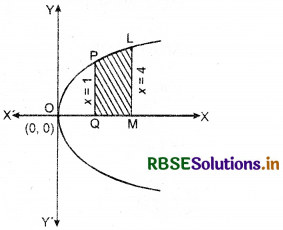
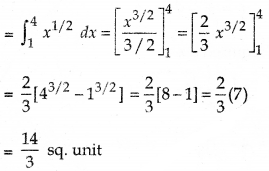

Question 2.
Find the area of the region bounded by y2 = 9x, x = 2, x = 4 and the x-axis in the first quadrant.
Answer:
Curve (parabola) y2 = 9x, is symmetrical about x-axis with vertex at origin O(0, 0). The area of the region bounded by the lines x = 2, x = 4, x-axis and curve y2 = 9x is shown in the figure below.
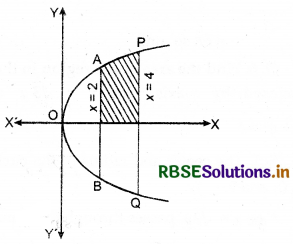
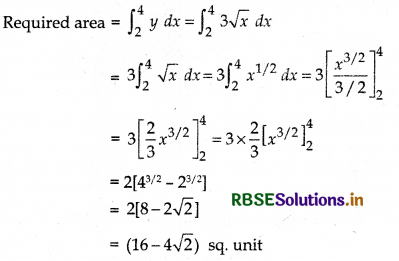
Question 3.
Find the area of the region bounded by x2 = 4y, y = 2, y = 4 and the y-axis ¡n the first quadrant.
Answer:
Curve x2 = 4y is a parabola whose vertex is at origin and it is symmetrical about x-axis.
The area of the region bounded by the lines y = 2, y = 4, y-axis and curve x2 = 4y is shown in the figure below.
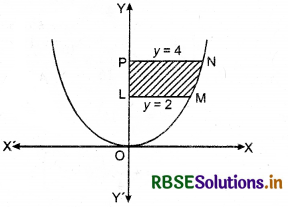
The required area is LMNPL.
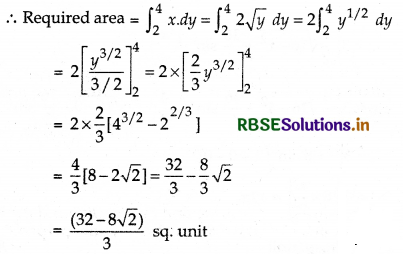

Question 4.
Find the area of the region bounded by the ellipse \(\frac{x^{2}}{16}+\frac{y^{2}}{9}\) = 1.
Answer:
Ellipse \(\frac{x^{2}}{16}+\frac{y^{2}}{9}\) = 1, is symmetrical about both x-axis and y-axis.
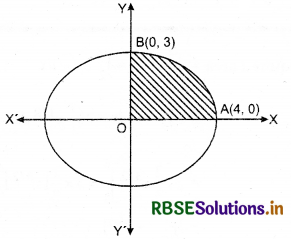
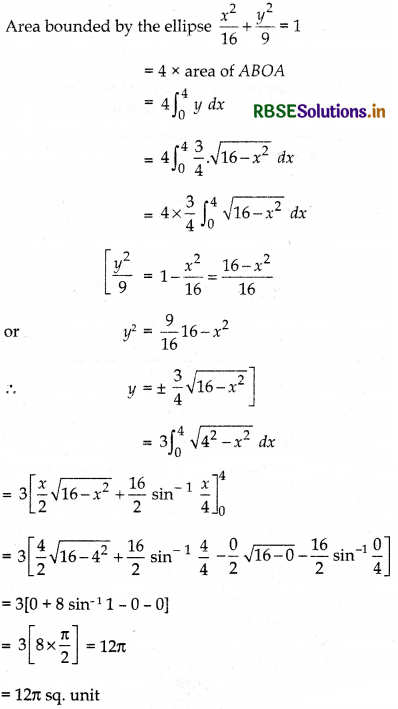
Question 5.
Find the area of the region bounded by the ellipse \(\frac{x^{2}}{4}+\frac{y^{2}}{9}\) = 1.
Answer:
Ellipse \(\frac{x^{2}}{4}+\frac{y^{2}}{9}\) = 1 is symmetrical about both axis. The center of this ellipse is at (0, 0).
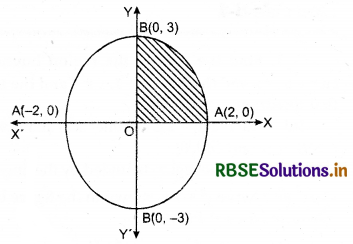
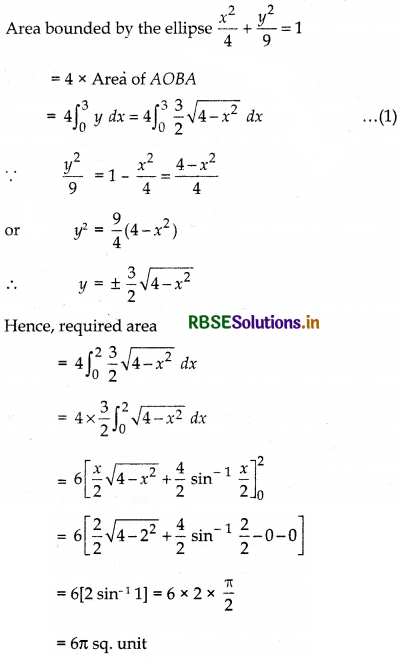

Question 6.
Find the area of the region in the st quadrant enclosed by x-axis, line x = √3 y and the circle x2 + y2 = 4.
Answer:
The centre and radius of the circle x2 + y2 = 4 is (0, 0) and 2.
Line x = √3y passes through (0, 0) and (√3, 1)
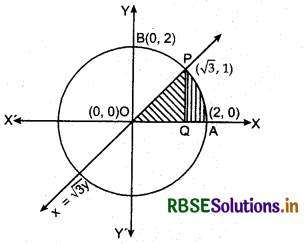
Required area = Shaded region
= Area of OQP + Area of QAP
= ∫ y(for line)dx + ∫ y(for circle)dx

Question 7.
Find the area of the smaller part of the circle x2 + y2 = a2 cut off by the line x = \(\frac{a}{\sqrt{2}}\).
Answer:
x2 + y2 = a2 is a circle with centre 0(0,0) and radius a.
Line x = \(\frac{a}{\sqrt{2}}\) is parallel to y-axis at a distance \(\frac{a}{\sqrt{2}}\) from origin.
Shaded region bounded by the circle x2 + y2 = a2 and y-axis a line x = \(\frac{a}{\sqrt{2}}\) is shown in the figure.
Points of intersection of line x = \(\frac{a}{\sqrt{2}}\) and circle x2 + y2 = a2 are
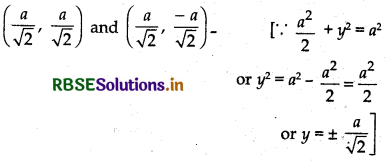
∴ Required area = 2[area of APQA]
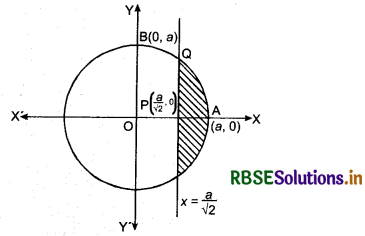
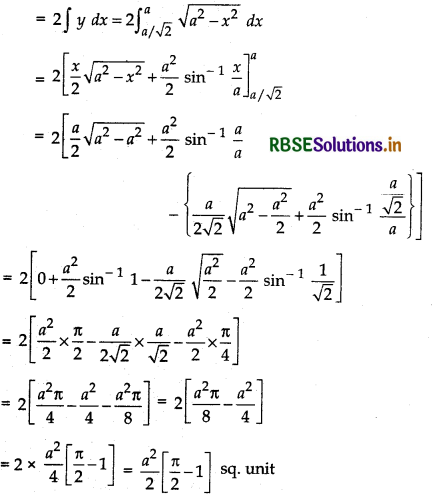

Question 8.
The area between x = y2 and x = 4 is divided into two equal parts by the line x = a. Find the value of a.
Answer:
Curve x = y2 is a parabola whose vertex is at origin and it is symmetrical about x-axis. Line x = 4 is parallel to y-axis at a distance 4 units from origin or y-axis.
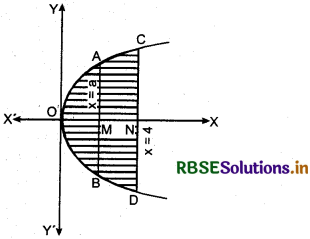
Area bounded by the curve x = y2 and line x = 4 is ODCA
Now, area of ODCO = 2 × CONC
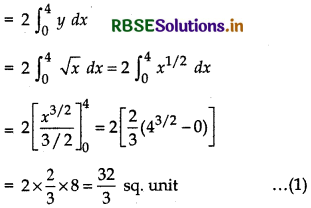
Line x = a is at a distance a units from y-axis.
Area bounded by the curve x = y2 and line x = a is AOBA
Now, Area of AOBA = 2 × Area of AOMA
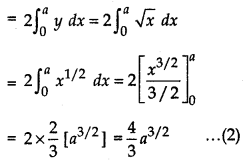
According to the question,
Area of ODCO = 2 × area of AOBA
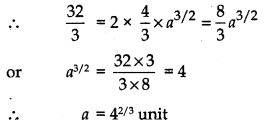
Question 9.
Find the area of the region bounded by the parabola y = x2 and y = |x|.
Answer:
Clearly, x2 = y represents a parabola with vertex at origin and it opens upwards.
Equation y = |x|, represent two lines y = x passing through the origin and makes an angle as 45° and 135° with the positive direction of the x-axis.
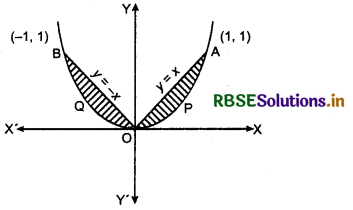
Lines y = x and y = - x cuts the parabola y = x2 at points O(0, 0), A (1, 1) and B(- 1, 1).
The required region is the shaded region as shown in
the figure. Both the regions are symmetrical about y-axis.
∴ Required area
= 2(shaded area in the first quadrant)
= 2 × area of APOA
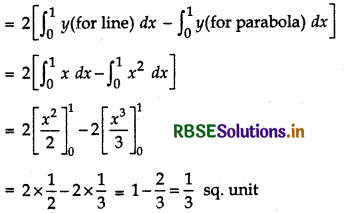

Question 10.
Find the area bounded by the curve x2 = 4y and the line x = 4y - 2.
Answer:
Clearly x2 = 4y is a parabola with vertex at origin 0(0, 0) and it opens upwards. Parabola x2 = 4y is symmetrical about y-axis.
Equation of curve x2 = 4y ....... (1)
Equation of line x = 4y - 2 ........ (2)
Solving equations (1) and (2), we get
(4y - 2)2 = 4y
or 16y2 + 4 - 16y = 4y
or 16y2 - 16y - 4y + 4 = 0
or 16y2 - 20y + 4 = 0
or 4y2 - 5y + 1 = 0
or 4y2 - (4 + 1)y + 1 = 0
or 4y2 - 4y - y + 1 = 0
or 4y(y - 1) - 1(y - 1) = 0
or (4y - 1) (y - 1) = 0
∴ 4y - 1 = 0 or y - 1 = 0
or y = \(\frac{1}{4}\) or y = 1
∴ From equation (2), we get
When y = \(\frac{1}{4}\), then x = 4 × \(\frac{1}{4}\) - 2 = - 1
When y = 1, then x = 4 × 1 - 2 = 2
∴ Points of intersection of line x = 4y - 2 and curve x2 = 4y are A(2, 1) and B\(\left(-1, \frac{1}{4}\right)\).
Clearly, shaded region is the required area AOBA as shown in figure below.
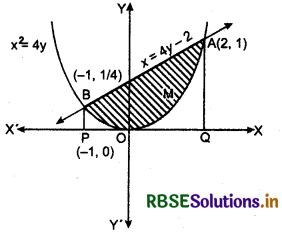
Area of AOBA
= area of AQOPBA - (area of AQO + area of OPB)
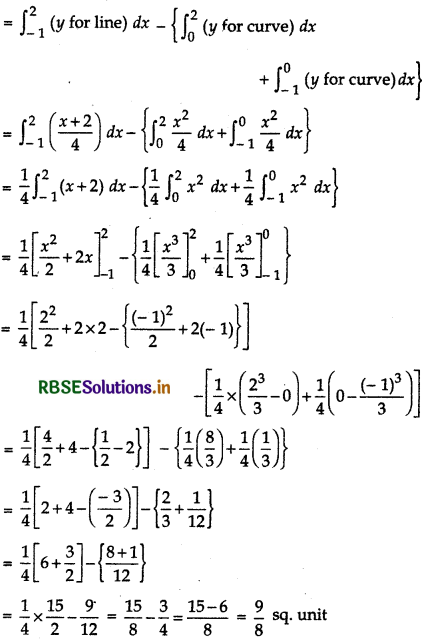
Question 11.
Find the area of the region bounded by the curve y2 = 4x and the line x = 3.
Answer:
The curve y2 = 4x is a parabola which is symmetrical about x-axis with vertex at origin O.
Line x = 3 is parallel to y-axis at a positive distance of 3 units from it.
Required area is AOBA which is shown in figure.
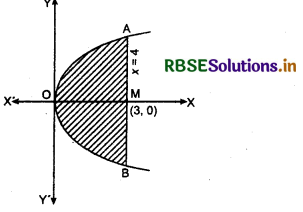
Area of AOBA = 2 × area of AMOA


Question 12.
Area lying in the first quadrant and bounded by the circle x2 + y2 = 4 and the lines x = 0 and x = 2 is:
(A) π
(B) \(\frac{\pi}{2}\)
(C) \(\frac{\pi}{3}\)
(D) \(\frac{\pi}{4}\)
Answer:
Shaded region of first quadrant is shown in figure by the circle x2 + y2 = 4 and the lines x = 0 and x = 2.
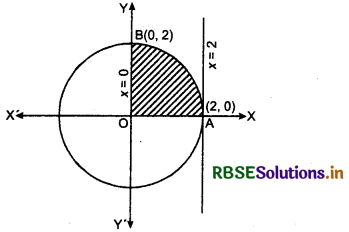
Required area AOBA
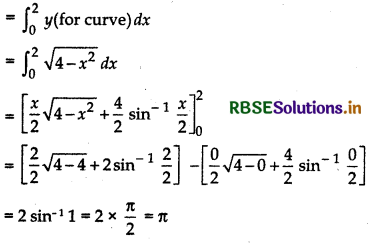
Hence, (A) is the correct answer.
Question 13.
Area lying in the first quadrant and bounded by the curve y2 = 4x, and the y-axis and the line y = 3 is:
(A) 2
(B) \(\frac{9}{4}\)
(C) \(\frac{9}{3}\)
(D) \(\frac{9}{2}\)
Answer:
Curve y2 = 4x is a parabola with vertex at origin O and it is symmetrical about x-axis.
Shaded area which is AOBA, bounded by the curve y2 = 4x, y-axis and line y = 3 is shown in the figure below.
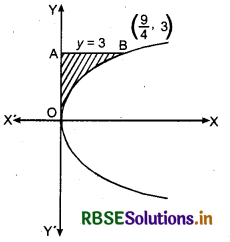
∴ Required area AOBA
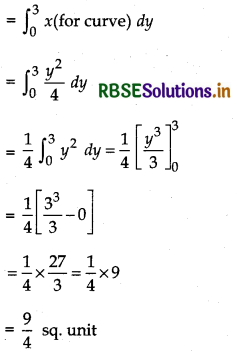
Hence, (B) is the correct answer.

- RBSE Class 12 Maths Notes Chapter 13 Probability
- RBSE Class 12 Maths Notes Chapter 12 Linear Programming
- RBSE Class 12 Maths Notes Chapter 11 Three Dimensional Geometry
- RBSE Class 12 Maths Notes Chapter 10 Vector Algebra
- RBSE Class 12 Maths Notes Chapter 9 Differential Equations
- RBSE Class 12 Maths Notes Chapter 8 Application of Integrals
- RBSE Class 12 Maths Notes Chapter 7 Integrals
- RBSE Class 12 Maths Notes Chapter 6 Application of Derivatives
- RBSE Class 12 Maths Notes Chapter 5 Continuity and Differentiability
- RBSE Class 12 Maths Notes Chapter 4 Determinants
- RBSE Class 12 Maths Notes Chapter 3 Matrices